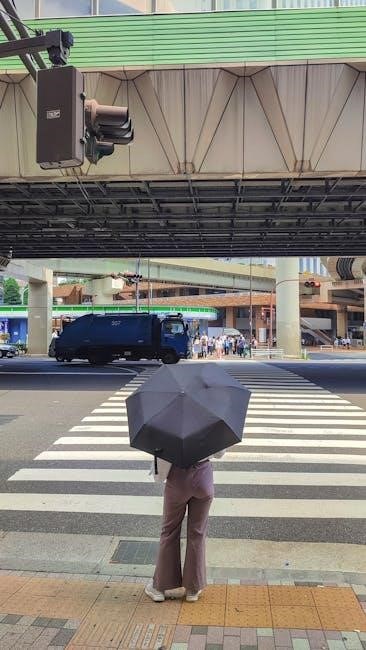The Pedestrian by Ray Bradbury: An Analysis

Ray Bradbury’s “The Pedestrian‚” often found in PDF format for easy access‚ offers a chilling glimpse into a dystopian future. The story serves as a potent analysis of societal trends‚ particularly the over-reliance on technology and the resulting isolation of individuals. It explores themes of conformity and the suppression of individuality.
“The Pedestrian‚” penned by Ray Bradbury‚ unfolds in a futuristic city in 2053‚ where technology dominates society. Leonard Mead‚ the protagonist‚ stands out as an anomaly‚ finding solace and joy in nightly walks through the deserted streets. Unlike the other residents‚ who are engrossed in their television screens‚ Mead relishes the solitude and the opportunity to observe the world around him.
One evening‚ during his customary stroll‚ Mead encounters a robotic police car‚ a symbol of the technological control that governs the city. The car questions Mead about his activities‚ finding his pedestrianism suspicious and abnormal. Mead’s explanations about being a writer and enjoying the simple act of walking are met with cold‚ unfeeling logic.
The robotic police car deems Mead’s behavior as regressive and arrests him for his lack of engagement with the dominant technological culture. He is taken to a psychiatric center for further evaluation‚ highlighting the dystopian society’s intolerance towards individuality and non-conformity. The story concludes with a stark portrayal of Mead’s forced removal from the streets‚ leaving the reader to contemplate the consequences of unchecked technological advancement and the suppression of human connection.
Setting and Context
Ray Bradbury’s “The Pedestrian” is meticulously set in the year 2053 in an unnamed city‚ a crucial element in understanding the story’s themes. This futuristic setting serves as a backdrop for exploring the potential consequences of unchecked technological advancement and societal obsession with entertainment. The city is depicted as eerily quiet and deserted‚ with most of its inhabitants glued to their television screens‚ creating a sense of isolation and uniformity.

The context of the story is rooted in Bradbury’s concerns about the growing influence of technology on human life. Published in 1951‚ during the rise of television as a dominant form of entertainment‚ “The Pedestrian” reflects Bradbury’s anxieties about the potential for technology to isolate individuals and erode social interaction. The story serves as a cautionary tale‚ warning against the dangers of passively consuming technology and losing touch with the natural world and human connection.
Furthermore‚ the Cold War era‚ with its emphasis on conformity and fear of individuality‚ also influenced Bradbury’s writing. “The Pedestrian” can be interpreted as a critique of societal pressures to conform and the suppression of dissenting voices‚ highlighting the importance of independent thought and the preservation of human individuality in an increasingly mechanized world.
Leonard Mead: The Protagonist
Leonard Mead‚ the protagonist of “The Pedestrian‚” is a compelling figure who embodies individuality and a yearning for connection in a technologically dominated society. Mead is portrayed as an anomaly‚ a man who finds solace and joy in walking the deserted streets of the city at night‚ observing the world around him‚ and engaging in independent thought; He is a writer‚ a profession that further emphasizes his creative and introspective nature‚ setting him apart from the passive consumers of technology that populate his world.
Mead’s nightly walks are not merely a form of exercise; they are an act of rebellion against the conformity and isolation that permeate his society. He is a keen observer‚ taking note of the details of his surroundings and finding beauty in the natural world‚ a stark contrast to the artificiality of the television-dominated homes he passes. His walks are a way for him to connect with his environment and maintain his sense of self in a world that increasingly values conformity over individuality.
Through Mead’s character‚ Bradbury highlights the importance of independent thought‚ creativity‚ and connection with the natural world. Mead’s arrest and subsequent institutionalization underscore the dangers of a society that suppresses individuality and punishes those who deviate from the norm‚ making him a symbol of resistance against the dehumanizing forces of technology and social control.
Themes: Technology and Social Control
“The Pedestrian” profoundly explores the intertwined themes of technology and social control‚ presenting a chilling vision of a future where technological advancements are used to manipulate and suppress individual thought and behavior. Bradbury portrays a society where television has become the primary form of social interaction‚ effectively isolating people within their homes and disconnecting them from the outside world. This reliance on technology has led to a decline in critical thinking and a widespread acceptance of conformity.
The empty streets and silent houses symbolize the extent to which technology has replaced human connection and engagement with the physical world. The robotic police car represents the ultimate form of social control‚ enforcing conformity and punishing those who deviate from the norm. The car’s lack of human emotion and its unwavering adherence to the law highlight the dehumanizing effects of technology when used as a tool of oppression.
Bradbury cautions against the uncritical acceptance of technology‚ suggesting that it can be used to erode individual freedoms and create a society where independent thought is viewed as a threat. The story serves as a warning about the dangers of allowing technology to dominate our lives and the importance of preserving human connection‚ critical thinking‚ and engagement with the world around us.
Themes: Isolation and Loneliness
In Ray Bradbury’s “The Pedestrian‚” the themes of isolation and loneliness are palpably woven into the narrative fabric‚ illustrating a society where human connection has withered in the face of technological immersion. Leonard Mead‚ the protagonist‚ embodies this isolation‚ as he is depicted as an anomaly in a world where people are glued to their television screens‚ detached from the outside world and each other. His nightly walks‚ a solitary act of defiance against the prevailing social norms‚ underscore his profound sense of loneliness.
The empty streets‚ once bustling with life‚ now stand as stark reminders of the absence of human interaction. The houses‚ described as dark and tomb-like‚ further emphasize the sense of isolation that pervades the community. Mead’s encounters with the robotic police car‚ a symbol of the dehumanized society‚ only serve to deepen his feelings of alienation. He is viewed as an outsider‚ a deviant‚ simply for engaging in an activity that was once considered normal – walking and observing the world around him.
Bradbury uses Mead’s character to highlight the dangers of a society that prioritizes technology over human connection. The story serves as a cautionary tale about the importance of maintaining social bonds and the devastating consequences of isolation and loneliness on the human spirit. It urges readers to reflect on the value of genuine interaction and the need to resist the forces that seek to disconnect us from one another.
Symbolism in The Pedestrian
Ray Bradbury’s “The Pedestrian” is rich in symbolism‚ adding layers of meaning to the narrative and enhancing its commentary on technology and society. Leonard Mead’s walks symbolize a yearning for a connection with the natural world and a rejection of the passive‚ screen-dominated existence embraced by the masses. The empty streets represent the desolation of human interaction‚ a consequence of technological absorption.
The houses‚ described as dark and lifeless‚ symbolize the emotional emptiness of the inhabitants‚ who are consumed by television and disconnected from reality. The television itself serves as a powerful symbol of conformity and social control‚ representing the opiate of the masses that keeps people docile and unthinking. The robotic police car embodies the dehumanizing aspects of technology‚ acting as an enforcer of societal norms and a suppressor of individuality.
The act of walking‚ in contrast to driving‚ symbolizes a more deliberate and mindful engagement with the environment. Mead’s appreciation for the natural world‚ as evidenced by his observations of the moon and the dew-covered lawns‚ highlights the beauty that is lost when people become detached from their surroundings. The story’s conclusion‚ with Mead being driven away to a psychiatric center‚ symbolizes the suppression of individuality and the punishment of those who dare to deviate from the norm. Bradbury uses symbolism to create a cautionary tale about the dangers of unchecked technological advancement.
Bradbury’s Poetic Style
Ray Bradbury’s “The Pedestrian” is distinguished by its poetic style‚ which enhances the story’s atmosphere and thematic resonance. Bradbury employs vivid imagery and figurative language to paint a stark contrast between the natural world and the technologically dominated society. His descriptions are often lyrical‚ imbuing the story with a sense of melancholy and foreboding.
Bradbury’s use of metaphors and similes creates a rich tapestry of sensory detail‚ drawing the reader into Leonard Mead’s world. He compares the houses to tombs‚ emphasizing the lifelessness of their inhabitants‚ and the television screens to flickering hearths‚ highlighting their role as the center of domestic life. The robotic police car is described in mechanical terms‚ underscoring its lack of humanity and its role as an enforcer of conformity.
The author’s poetic style also contributes to the story’s thematic concerns. By contrasting the beauty of the natural world with the sterile environment of the city‚ Bradbury underscores the dehumanizing effects of technology. His use of language evokes a sense of isolation and alienation‚ mirroring Mead’s experience as an outcast in his own society. Bradbury’s poetic prose elevates “The Pedestrian” beyond a simple science fiction story‚ transforming it into a meditation on the human condition and the dangers of unchecked technological progress. The careful choice of words amplifies the story’s emotional impact.
Dystopian Elements
“The Pedestrian” showcases several key dystopian elements‚ painting a grim picture of a future society controlled by technology and conformity. The story presents a world where individuality is suppressed‚ and people are isolated within their homes‚ glued to their television screens. This creates a sense of social alienation‚ a hallmark of dystopian literature.

The absence of human interaction and the dominance of technology are central to the story’s dystopian nature. The streets are deserted‚ and the only authority figure is a robotic police car‚ symbolizing the dehumanization of law enforcement and the state’s control over its citizens. The robotic police car represents the cold‚ unfeeling nature of this society.
Leonard Mead’s arrest for the simple act of walking highlights the oppressive nature of this dystopian world. His nonconformity is seen as a threat to the established order‚ and he is punished for his individuality; The threat of confinement in a psychiatric center further underscores the lack of freedom and the suppression of dissent. The story serves as a cautionary tale‚ warning against the dangers of unchecked technological advancement and the erosion of human connection. Bradbury masterfully creates a world where the pursuit of technological progress has led to a loss of humanity.
Conflict: Man vs. Society
The central conflict in “The Pedestrian” is the classic struggle of man versus society‚ embodied by Leonard Mead’s defiance against a conformist‚ technology-obsessed world. Mead‚ a writer who enjoys solitary walks‚ represents individuality and a connection to the natural world. He stands in stark contrast to a society that has retreated into the virtual realm of television‚ isolating themselves from each other and the world around them.
The conflict arises when Mead is stopped by a robotic police car‚ an automated symbol of societal control. The car questions his activities‚ deeming his walks suspicious and abnormal. This encounter highlights the clash between Mead’s desire for freedom and self-expression and the rigid‚ unyielding expectations of the society he inhabits.
The robotic police car represents the collective will of a society that values conformity over individuality. Mead’s inability to justify his actions to the machine underscores the futility of resisting a system that prioritizes control and obedience. His eventual arrest and impending psychiatric evaluation symbolize the ultimate triumph of society over the individual‚ a chilling reminder of the potential consequences of unchecked conformity and the suppression of independent thought. The story serves as a warning about the dangers of sacrificing individuality for the sake of societal harmony.
The Robotic Police Car
The robotic police car in Ray Bradbury’s “The Pedestrian” is a potent symbol of the dehumanized‚ technologically advanced society of 2053. It is not merely a vehicle of law enforcement but a representation of the oppressive control exerted by the state over individual behavior. The car’s cold‚ mechanical voice and unwavering adherence to protocol highlight the absence of human empathy and understanding in this dystopian world.
The robotic police car is significant because it embodies the societal shift away from human interaction and judgment. It operates solely on programmed directives‚ devoid of compassion or the ability to consider individual circumstances. The car’s interrogation of Leonard Mead underscores the absurdity of a society that views individuality as a threat.
The encounter with the robotic police car marks the climax of the story‚ signifying the complete subjugation of the individual to the collective. The car’s decision to transport Mead to a psychiatric center for his “regressive tendencies” reveals the extent to which conformity is valued above all else. The robotic police car serves as a chilling reminder of the potential consequences of technological advancement without ethical considerations‚ warning against a future where machines dictate human behavior and suppress individuality. The car represents the cold‚ unfeeling face of a society that has lost its humanity.
Imagery and its Effect
Ray Bradbury masterfully employs vivid imagery in “The Pedestrian” to create a stark contrast between the natural world and the artificial‚ technologically dominated society. He paints a picture of a cold‚ gray city where people are glued to their television screens‚ effectively shutting themselves off from the outside world. This imagery evokes a sense of isolation and alienation‚ highlighting the protagonist‚ Leonard Mead’s‚ unique appreciation for the beauty of nature.
The descriptions of Mead’s solitary walks are filled with sensory details that bring the deserted streets to life. Bradbury’s use of similes and metaphors‚ such as comparing the houses to “tombs” and the television screens to “glowing hearths‚” reinforces the theme of societal decay and the loss of genuine human connection. The imagery also emphasizes the protagonist’s isolation as he walks alone through the empty streets.

The stark contrast between the natural world and the artificial environment serves to highlight the dehumanizing effects of technology. The vivid descriptions of nature emphasize its beauty and power over Mead‚ the natural world even gives Mead a sense of freedom and peace. Bradbury’s use of imagery effectively conveys the story’s themes of conformity‚ social control‚ and the importance of individuality in a world increasingly dominated by technology. The powerful imagery leaves a lasting impression on the reader‚ prompting reflection on the potential consequences of unchecked technological advancement.
Discussion Questions and Further Analysis
The Ending and its Implications
The ending of “The Pedestrian” is both abrupt and deeply unsettling‚ leaving a lasting impression on the reader. Leonard Mead is arrested by a robotic police car for the crime of walking‚ an activity deemed suspicious and abnormal in this technologically obsessed society. He is taken to a psychiatric center for further evaluation‚ implying that his nonconformity is seen as a sign of mental instability.
The implications of this ending are profound. It suggests a future where individuality is not only discouraged but actively suppressed‚ where independent thought is considered a threat to social order. The robotic police car‚ acting as an extension of the conformist society‚ symbolizes the chilling power of technology to enforce social control. Mead’s fate serves as a warning about the dangers of surrendering our humanity to technological advancement.
The story’s conclusion prompts us to question the value of conformity and the potential consequences of a society that prioritizes technological advancement over human connection. It also raises concerns about the role of government and law enforcement in regulating individual behavior. The ending leaves the reader with a sense of unease and a lingering question about the future of individuality in an increasingly technology-driven world‚ and what happens when technology robs individuals of their humanity.


